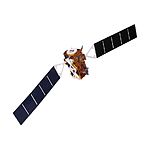Sentinel-1B
Appearance
| Mission type | Earth observation |
|---|---|
| Operator | ESA |
| COSPAR ID | 2016-025A |
| SATCAT no. | 41456 |
| Website | Sentinel-1 (ESA) |
| Mission duration | 7 years (minimum)[1] |
| Spacecraft properties | |
| Spacecraft type | Sentinel-1 |
| Bus | PRIMA[2] |
| Manufacturer | Thales Alenia Space Airbus Defence and Space[1] |
| Start of mission | |
| Launch date | 2016-04-25 21:02 UTC [3] |
| Rocket | Soyuz-STA/Fregat-M[4] |
| Launch site | Kourou ELS[4] |
Sentinel-1B is a European radar imaging satellite launched on 2016-04-25. It is the second of two satellites in the Sentinel-1 constellation, part of the European Union's Copernicus programme on Earth observation. The satellite carries a C-SAR sensor, capable of providing high-resolution imagery regardless of weather conditions.
Satellite made its first observation on 28 April, capturing 250 km wide image of Austfonna glacier on Svalbard.[5]
See also
References
- ^ a b "Facts and figures / Sentinel-1". ESA. Retrieved 28 April 2016.
- ^ "Thales Alenia Space flies high at the Space Symposium". Thales Group. 13 April 2015. Retrieved 28 April 2016.
- ^ "Sentinel-1B liftoff delayed another 24 hours". ESA. 23 April 2016. Retrieved 28 April 2016.
- ^ a b "Sentinel 1A, 1B, 1C, 1D". Gunter's Space Page. Retrieved 28 April 2016.
- ^ "Sentinel-1B delivers". ESA. 28 April 2016. Retrieved 28 April 2016.

